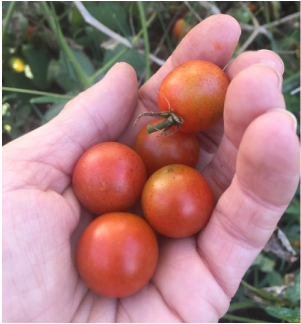|
These are among the last tomatoes left on my plants from this summer. Their skins are getting a little thicker but the flavor is still better than you could ever find in a store. And because this is how I seem to roll in life, I'm going to let myself write about these "last" tomatoes. Maybe next year the stars will align to write about the first tomatoes of the season.
Part of our health, a major part in fact, is about what we put into our bodies. As a mother and a therapist, I really focus on how important food is to how we feel. My roots are steeped in gardening and nutrition- my parents had a huge garden and baked quite religiously and my undergraduate degree is in Biology with a minor in Nutrition. So it is not surprising that I tend to get quite excited about finding the most delicious and nutritious ways to eat. A book that I mentioned earlier in the year, "Eating on The Wild Side" by Jo Robinson has sorted through a myriad of nutrition and scientific journals to find the best vegetables and fruit to grow and eat. I summarize some of her findings below. According to the book, red cherry tomatoes are the most flavorful variety and also have the highest amounts of lycopene (a powerful phytonutrient). As tomatoes have been cultivated over time, many varieties have lost their high nutritional content. Jo lists the most nutritious varieties to eat- a few examples are Sun Cherry and Red Pear. Other varieties of tomatoes are also recommended to grow and include San Marzano, Abraham Lincoln, and Giant Belgium. Something that is worth noting is that cooking tomatoes increases the lycopene content by more than double. And adding a bit of tomato paste isn't a bad idea either since it has about 10x as much lycopene as a regular tomato. As I think about these last tomatoes, I am excited to make one last batch of my favorite summer dinner - fresh tomato, garlic and basil pasta. I was excited to try and begin growing garlic a year ago and it was a total success! Garlic is a highly nutritious allium and is incredibly easy to grow. Two varieties that are known for their flavor and longer storage life are Inchellium Red and Chilean Silver. I grab a few of these garlic cloves that I grew earlier this spring to peel and mince. Here is a tip worth remembering- The secret to optimizing the protective agents contained in garlic is to mince it and let it sit 10 minutes before cooking it. What happens when the garlic is smashed is that the two compounds which are separate in a whole clove, alliin and alliinase, combine and the powerful result is allicin. This compounds need a few minutes to stabilize and if you cook them right away, you'll needlessly lose a lot of extra nutrition . The last ingredient I use is basil which I grow all summer long. It browns quickly when cut but this also releases more of it phytonutrients. Since the thin skin is less stable, it's best to reserve half the garlic to julienne right before serving. As the weather moves towards colder temperatures, I usually do one big harvest of my basil and make pesto with different types of nuts. I freeze it in ice cube trays and store it for whenever I get an itch for summer freshness in the colder months ahead. So as I look around my summer garden and pick these last few tomatoes and basil, I say farewell. Its been a good season but I am looking forward to what will come next....salad greens, kale and a lot less weeds!
1 Comment
|
AuthorKimberly Simpson, a native of New Jersey, graduate of Wheaton College and resident of Nashville. Married and mother of three children. Lover of the ocean, gardens, yoga, cooking and travel. Archives
July 2019
Categories |


 RSS Feed
RSS Feed